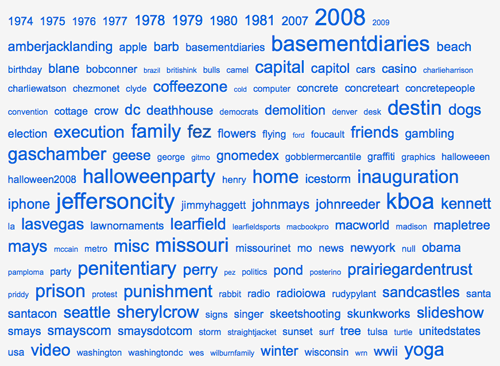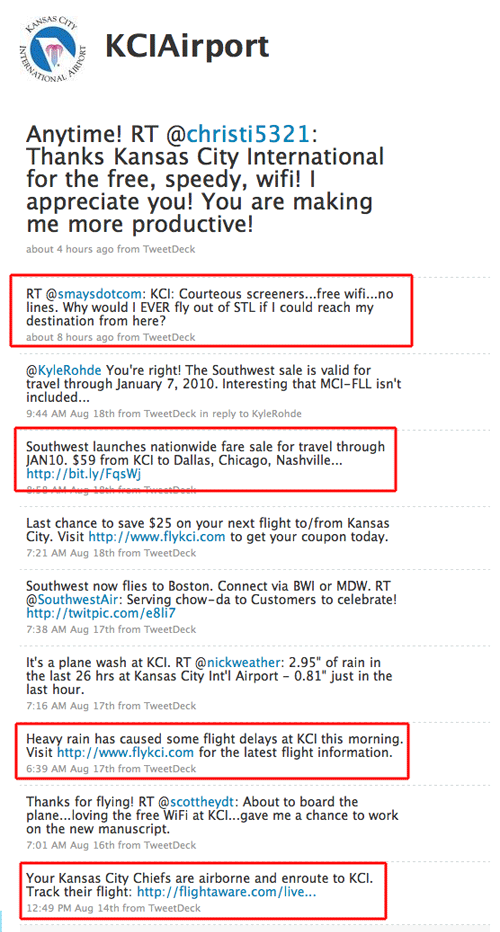Ah, starting to make sense. I’d very much like to try this out. I no longer rely on email as my primary means of communicating online. Google Wave just might be The Thing.
Tag Archives: social media
“The audience is being assembled by the audience”
NYU professor and Internet thinker Clay Shirky on the future of accountability journalism in a world of declining newspapers. On the advertising-based business model of journalism:
“Best Buy was not willing to support the Baghdad bureau because Best Buy cared about news from Baghdad. They just didn’t have any other good choices.”
On the death of the home page:
“The number of people who go to the Times’ homepage as a percentage of total readership falls every year — because you don’t go to the Times, you go to the story, because someone Twittered it or put it on Facebook or sent it to you in email. So the audience is now being assembled not by the paper, but by other members of the audience.”
“Advertising Agencies and Social Media: A Culture Clash”
For some years I have sensed a fundamental shift in how we –the consuming public– feel about advertising. The following is from a post by Jason Falls. [Alas, the original post is gone.] I was tempted to just repost the piece in its entirety. He begins with the philosophical differences between advertising and social media:
“Social media is, in many ways, the antithesis of advertising. Advertising is one-way communications aimed at large groups of consumers. Social media is two-way communications that requires listening as well as speaking. It can also be said that social media is a multiple-way communications method as brands can speak and listen, but also watch other consumers talk to each other. An agency’s creatives and strategic planners suddenly having to factor in listening and observing to their communications process after decades of just shouting from the roof tops presents a seismic culture shift.
Social media is also about building relationships. Advertising is about driving people to a buying decision. In fact, I would propose that in most cases, advertising has nothing to do with a relationship. It’s all about persuading someone to take action, not discussing the decision-making process and becoming a trusted resource for the person choosing. As Chris Heuer says, good marketing today doesn’t try to sell the customer on something. It tries to help them buy it.
Similarly, it can be said that the essence of social media, in many ways, is good customer service. I would propose that, with exceptions certainly, advertising agencies have never cared about serving the customer. They care about making the sale. Advertising is most often used to drive customers to purchase, not care for them after the fact.
So, philosophically, advertising and social media are very different. Creatives, client services folks, account planners and the like are being asked to undertake a new method of communications that runs counter to everything they’ve ever been taught.”
A small shop within our company has been providing social media services to clients for a couple of years and it immediately became clear to us why advertising agencies weren’t keen on producing social media content for their clients. Again, Mr. Falls:
“Content creation also doesn’t scale well and is problematic for billing. Let’s say you have 20 brands producing social media content and you hire two people to produce that content. Depending upon the brand, audience and strategy, if they’re doing a good job, they’re producing an average of a blog post, Facebook content, several Tweets and perhaps video, images or some other type of content for each client every day. Can you write 10 blog posts in a day?
And how about this billing scenario: Let’s say a full-time agency employee producing content for a client is working 10 hours per week on that client’s social media efforts. They’re billed out at roughly $75 per hour. At that rate, which is conservative in price and volume, you’re billing $36,000 per year for their services as an agency. At the same time, you can go out and pay free-lance bloggers $25 per post (and that’s on the high end in most circumstances) and produce a similar volume of content for $6,500 per year (a blog post per day, five days per week, which is an aggressive clip for many agencies). How will you answer your client when they call you with a big, “WTF?”
If you are remotely involved in “old media” and/or advertising, I encourage you to read Mr. Fall’s complete post.
Gnomedex 9: Frank Eliason, the Comcast Cares guy on Twitter
Tag cloud
We (yes, there IS a mouse in my pocket) migrated one of our websites over to WordPress this week. As near as we can determine, more than 46,000 stories were imported. My role in this has been modest but I did spend a good bit of time working with the categories, keywords, tags and other meta data used to organize all of those news and sports stories.
There are less than 5,000 posts to this blog but it would be impossible (okay, very difficult) to find anything without a good tagging scheme. One of the more common approaches to displaying those tags is the “tag cloud.” I have one on the right side of this page, near the bottom. And here’s the tag cloud for my flickr account.

My friend Scott doesn’t like how tag clouds use different size text to indicate the most and least common topics. He thinks it looks “sloppy.” I find the visual cue very intuitive and easy to use. (I can see I have some clean-up to do)
Strangely, tagging is a bit like curling your tongue. Some people can do it and some just can’t. I’m getting better at it.
Is “social media the new punk rock?”
I wasn’t much into punk and can’t say I really understood it. The video draws some interesting comparisons. [via Hear2.0]
What does it mean with the doctor tweets “oops?”
I got a call this morning from Matt Kelley, a reporter for Radio Iowa (one of Learfield’s news networks). He was working on a story involving Twitter and he wanted to check a couple of terms. Here’s the story (minus the audio):
A Cedar Rapids medical center plans to use the social media tool Twitter to broadcast a surgery to the world next week. Doctors at St. Luke’s Hospital will perform a hysterectomy, and other procedures, as people who’re interested follow along via web browser or mobile device. Hospital spokeswoman Sarah Rainey (RAY-nee) says it’s an educational opportunity.
Rainey says, “We have marketing consultants who will be in the operating rooms with the surgeons as the surgery takes place and as the physician communicates exactly what he’s doing, we will have our consultants tweeting, or typing in conversation to bring it to the outside world.” She says two doctors will be performing the operation on a 70-year-old woman using robotic surgery techniques. The play-by-play will be sent out over the micro-blogging service in messages of 140 characters or less.
“He’ll be talking about how the anesthesiologist is now placing the patient under sedation and here’s my first step, so he will be talking as he goes through the procedure,” Rainey says. “You’ll hear him say, ‘Scalpel, please,’ or whatever he may need to instruct the O-R team to help him with.” She expects a wide host of Iowans — and people around the globe — to follow the surgery, starting at 10 AM next Monday.
She says they’re targeting people in the Twitter audience, roughly between the ages of 25 and 45. “We’re looking for people that just might want the opportunity to go into an O-R suite and see what happens without visually seeing all of the stuff that maybe they don’t care to see,” Rainey says. The hospital recently featured a “webcast” of the same type of surgery so anyone in the world could watch it live over their computers.
“With the webcast, you actually got to see everything that was going on in the O-R suite,” Rainey says. “It might be cutting open the patient, it might be a little blood, it might be the suction part, so for some people it might’ve been too much. Tweeting, on the other hand, is communicating through emails and tweets so it’s a little gentler on the eyes.” She says St. Luke’s will be the first Iowa hospital to “Twitter-cast” a surgery. To follow it, go to the hospital’s website “www.stlukescr.org” and click on the Twitter icon.
My friend David insists this is a “gimmick” and nothing more. That nobody would have the slightest interest in following this procedure on Twitter. I’m not as convinced.
Seperating the Twitter wheat from the chaff
I think I mentioned trying TwitBlock.org, a website that scans your Twitter followers and ranks them for “spamminess.” Higher the score, more likely to be spam. Looks at things like how many people you foll0w, how many times you’ve tweeted, and so forth. It’s not perfect but it’s better than nothing. And my rule of thumb is, “When in doubt… block.”
I’ve heard from one acquaintance who wanted to know why I blocked him. I unblocked and the pot’s right now. But there are sure to be more. Just ping me.
KCI making good use of Twitter
I twittered a few nice words about the Kansas City International Airport this morning and someone at KCI was watching or searching. Either way, they were listening and retweeted my praise. A quick check of their Twitter stream provides such useful nuggets as special prices by airlines; news that the Chiefs are homeward bound; update on the weather; links the twitter feeds of airlines serving KCI. All good stuff.
Sure, they only have a couple hundred followers but that grow. And the cost? A few minutes by someone with a clue. If you fly regularly from KC, why wouldn’t you tap this resource? Well done @KCIairport
Honey, I’m home!
Yes, I am easily seduced. I admit it. I’m like a pillow, I keep the impression of the last person who sat on me. Twitter, Posterous… I love new stuff and tend to get carried away. I’ve posted her less frequently since I began dallying with these new tools. But, as Dave Winer reminds us (in a post to Robert Scoble regarding sale of FriendFeed to MySpace Facebook), I can always come home to momma.
“Our blogs are still there, as is the web and the Internet. They never went away just because we foolishly flirted with something fast and easy and seductive. Our blogs never went away, they’re still ready to share our ideas and connect us with others. We’ll go back to basics now, take what we learned from this round of innovation, and build it for real this time.”
I never got the FriendFeed bug but I can’t believe MySpace Facebook owning it is good news for users. But hey, if MS bought Yahoo! they’d probably screw up flickr, so…
The point is, my blog is mine. Nobody can buy it or mess with it. It’s my place to “write things down.”

